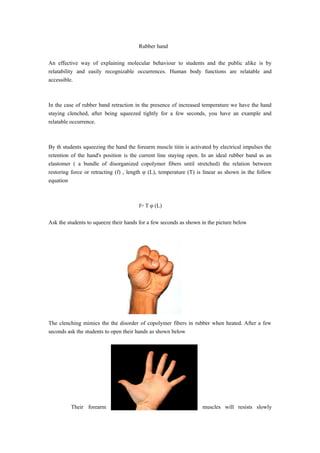Rubber hand
- 1. Rubber hand An effective way of explaining molecular behaviour to students and the public alike is by relatability and easily recognizable occurrences. Human body functions are relatable and accessible. In the case of rubber band retraction in the presence of increased temperature we have the hand staying clenched, after being squeezed tightly for a few seconds, you have an example and relatable occurrence. By th students squeezing the hand the forearm muscle titin is activated by electrical impulses the retention of the hand's position is the current line staying open. In an ideal rubber band as an elastomer ( a bundle of disorganized copolymer fibers until stretched) the relation between restoring force or retracting (f) , length ĶÕ (L), temperature (T) is linear as shown in the follow equation f= T ĶÕ (L) Ask the students to squeeze their hands for a few seconds as shown in the picture below The clenching mimics the the disorder of copolymer fibers in rubber when heated. After a few seconds ask the students to open their hands as shown below Their forearm muscles will resists slowly
- 2. opening this mimics the cooling and slow return to ambient temperature of rubber. Recap ? ? ? Hand clench is analog for retraction of rubber Electrical impulse analog for heat that causes retraction Opening of hand analog for rubber's return to ambient temperature


